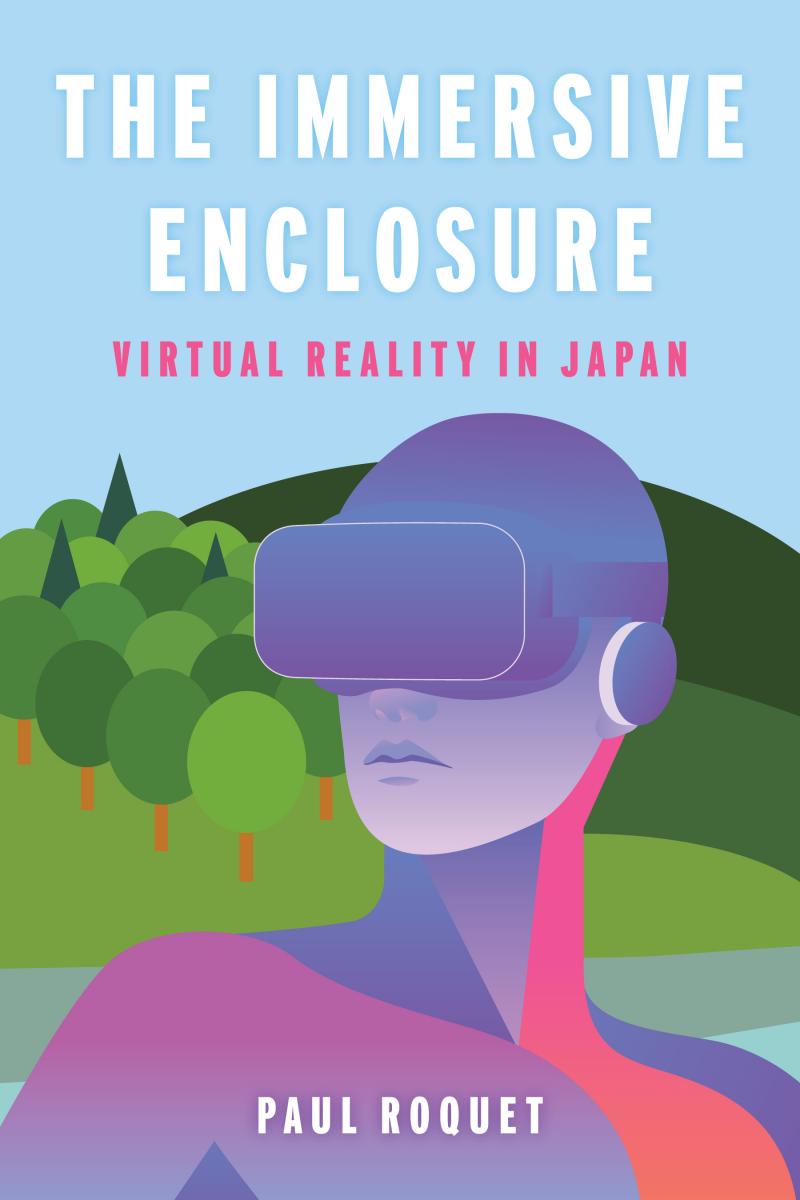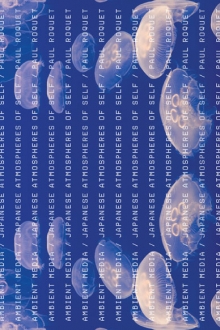Books
|
The Immersive Enclosure: Virtual Reality in Japan (Columbia University Press, 2022)
Although virtual reality promises to immerse a person in another world, its true power lies in its ability to sever a person’s spatial situatedness in this one. This is especially clear in Japan, where the VR headset has been embraced as a way to block off existing social environments and reroute perception into more malleable virtual platforms. Is immersion just another name for enclosure? In this groundbreaking analysis of virtual reality, Paul Roquet uncovers how the technology is reshaping the politics of labor, gender, home, and nation. He examines how VR in Japan diverges from American militarism and techno-utopian visions and becomes a tool for renegotiating personal space. Individuals turn to the VR headset to immerse themselves in three-dimensional worlds drawn from manga, video games, and genre literature. The Japanese government promises VR-operated robots will enable a new era of remote work, targeting those who could not otherwise leave home. Middle-aged men and corporate brands use VR to reimagine themselves through the virtual bodies of anime-styled teenage girls. At a time when digital platforms continue to encroach on everyday life, The Immersive Enclosure takes a critical look at these attempts to jettison existing social realities and offers a bold new approach for understanding the media environments to come. Reviews: Choice, H-Net: Sci-Med-Tech, Journal of Japanese Studies, Explorations in Media Ecology, Japan Review. Winner of the Lewis Mumford Award for Outstanding Scholarship in the Ecology of Technics from the Media Ecology Association. |
|
Ambient Media: Japanese Atmospheres of Self (University of Minnesota Press, 2016) Available open access via Manifold (web) and pdf
Ambient Media examines music, video art, film, and literature as tools of atmospheric design in contemporary Japan, and what it means to use media as a resource for personal mood regulation. Paul Roquet traces the emergence of ambient styles from the environmental music and Erik Satie boom of the 1960s and 1970s to the more recent therapeutic emphasis on healing and relaxation. Focusing on how an atmosphere works to reshape those dwelling within it, Roquet shows how ambient aesthetics can provide affordances for reflective drift, rhythmic attunement, embodied security, and urban coexistence. Musicians, video artists, filmmakers, and novelists in Japan have expanded on Brian Eno’s notion of the ambient as a style generating “calm, and a space to think,” exploring what it means to cultivate an ambivalent tranquility set against the uncertain horizons of an ever-shifting social landscape. Offering a new way of understanding the emphasis on “reading the air” in Japanese culture, Ambient Media documents both the adaptive and the alarming sides of the increasing deployment of mediated moods. Arguing against critiques of mood regulation that see it primarily as a form of social pacification, Roquet makes a case for understanding ambient media as a neoliberal response to older modes of collective attunement—one that enables the indirect shaping of social behavior while also allowing individuals to feel like they are ultimately in control. Selected open access reviews: All the Anime; Electronic Journal of Contemporary Japanese Studies. Other reviews: "Immateriality and Absence in the Search for Self" in Cultural Politics; Emotion, Space, and Society; Japan Times; International Journal of Communication; Journal of Japanese and Korean Cinema; Journal of Japanese Studies; The Year's Work in Critical and Cultural Theory. |
Journal Articles + Book Chapters
-
"Japan's Retreat to the Metaverse." Media, Culture & Society 45.7 (2023) [OA version]
-
“Solo Animation in Japan: Empathy for the Drawn Body,” in the Routledge Handbook of Japanese Cinema. Routledge, 2021 [OA version]
-
"Acoustics of the One Person Space: Headphone Listening, Detachable Ambience, and the Binaural Prehistory of VR." Sound Studies 7.1 (2021) [OA version]
-
"Ambiance in and Around the Virtual Reality Headset." Proceedings of the 4th International Congress on Ambiances, Alloaesthesia: Senses, Inventions, Worlds (2020)
-
"Telepresence Enclosure: VR, Remote Work, and the Privatization of Presence in a Shrinking Japan." Media Theory 4.1 (2020)
-
"Empathy for the Game Master: How Virtual Reality Creates Empathy for Those Seen to Be Creating VR" and co-authored Introduction to VR: Immersion and Empathy special issue of the Journal of Visual Culture 19.1 (2020)
-
"Media," in Connectedness: An Incomplete Encyclopedia of the Anthropocene. Strandberg, 2020.
-
“From Animation to Augmentation: Dennō Coil and the Composited Self.” Animation 11.3 (November 2016) [OA version]
-
“A Blue Cat on the Galactic Railroad: Anime and Cosmic Subjectivity,” Representations 128 (Fall 2014)
-
“Carbon as Creation: Tsuji Naoyuki’s Charcoal Anime,” Mechademia 9 (2014)
-
“The Domestication of the Cool Cat” in The Cultural Career of Coolness: Discourses and Practices of Affect Control in European Antiquity, the United States, and Japan. Lexington Books, 2013
-
“Ambient Landscapes from Brian Eno to Tetsu Inoue,” Journal of Popular Music Studies 21.4 (2009)
-
“Ambient Literature and the Aesthetics of Calm: Mood Regulation in Contemporary Japanese Fiction,” Journal of Japanese Studies 35.1 (Winter 2009)
-
“Reencountering Lee Ufan,” Octopus: A Visual Studies Journal Vol. 3: Import/Export (Fall 2007)
Online and Other Media
-
"「kankyō ongaku」の発明” and "細野晴臣、アンビエントの旅行者," Ele-king magazine アンビエント・ジャパン special issue (in Japanese; October 2023) [English version of the first piece]
-
"Learning from VR Motion Sickness," CAVRN (March 12, 2023)
-
"In the Mood," Real Life (April 26, 2021)
-
"The Body Shop," LOGIC magazine. Issue 8: Bodies (Summer 2019)
-
“Peripheral Visions,” Real Life (July 19, 2018)
-
“The Boombox on the Bus: Erik Satie’s Furniture Music in 2016,” University of Minnesota Press blog (February 24, 2016)
-
“Unhinged Desire (At Home with Obayashi)” Blu-ray/DVD booklet for Hausu (Masters of Cinema, 2010)
-
“Obayashi Nobuhiko, Vagabond of Time,” Midnight Eye feature article (November 10, 2009)
-
Towards the Bowels of the Earth: Butoh Writhing in Perspectives. Book published via Lulu Press, 2004
Translations
-
Nakane Chie, “Group Characteristics based on ‘Place’ (1967)” Review of Japanese Culture and Society 25. Special Issue: Working Words: New Approaches to Japanese Studies (2013)
-
Hasegawa Hitomi, “The Group 1965: Shining Under the Spotlight.” Catalogue for The Group 1965: We Are Boys!, Kunsthalle Düsseldorf, Germany (May - July 2011)
Note: pdfs above posted for scholarly/personal use only; any citation or excerpting should give proper attribution. For permission for other uses, please contact me or the publisher.



